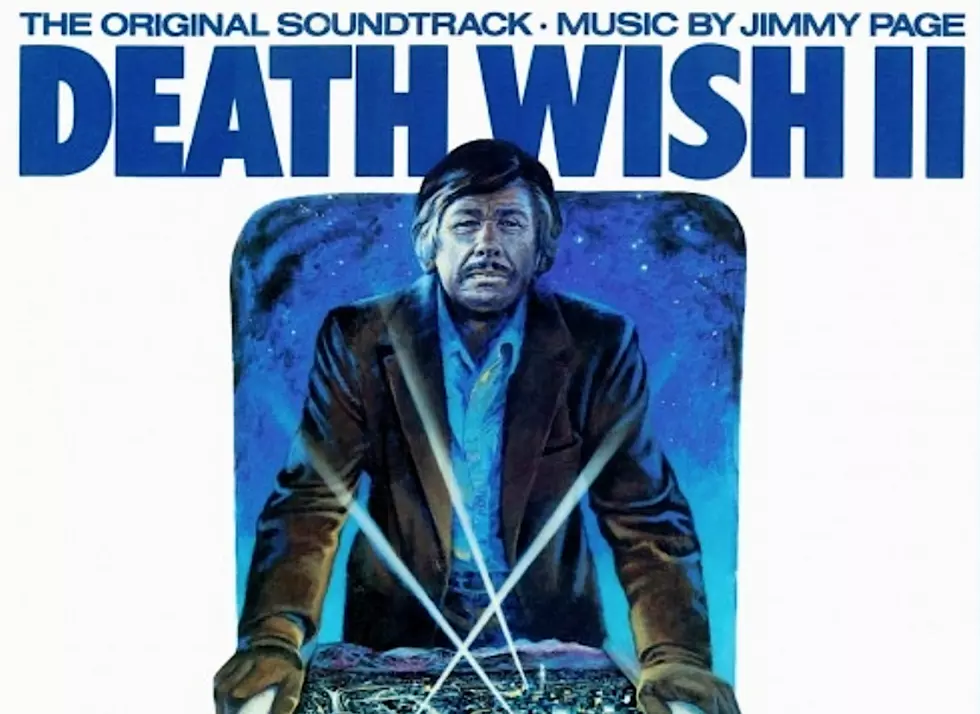
When Jimmy Page Returned With the ‘Death Wish II’ Soundtrack
The sudden death of drummer John Bonham in September 1980 didn’t just spell the end of Led Zeppelin. For a time, the surviving members of the band disappeared completely from the spotlight.
Guitarist Jimmy Page was the first to release new material – though not in the short-lived XYZ supergroup with Yes members Chris Squire and Alan White, which never released an album. Instead, it was a last-minute soundtrack composition for Death Wish II, issued on Feb. 15, 1982.
The genesis for the project came about when the movie's director – Michael Winner, who happened to be Page’s next-door neighbor – rang up the guitarist and pitched the idea.
“I’d lived next door to Jimmy for many years. I’d never seen him, never spoken to him,” Winner told Uncut, acknowledging Page was “in a down period” at the time. “We did a deal, which was very sensible of [Led Zeppelin manager] Peter Grant, because what he wanted to do was restore Jimmy back to creativity. A very sensible thing to do, it didn’t matter whether he was paid a lot or not. I think this was a very wise decision, he did a deal to get Jimmy back into action.”
Page was given only a few weeks to put the music together, and immediately hunkered down. “He saw the film, we spotted where the music was to go and then he said to me, 'I don’t want you anywhere near me, I’m going to do it all on my own,'" Winner recalled. Doing a soundtrack to the sequel of a 1974 movie starring Charles Bronson as a vigilante seeking street justice for the murder of his wife and assault on his daughter gave Page the opportunity to explore avenues he wasn't able to in Led Zeppelin. He also needed to put a band together.
“I had a chance to go in the studio and do some really experimental stuff. Well, it was experimental to me,” Page told Chris Cornell in 2015. “It involved guitar synthesizer, and I was able to work with an orchestra and some very, very fine musicians. There was a drummer, Dave Mattacks, who played with Fairport Convention. The bass player, David Paton, was phenomenal; he was from the Bay City Rollers, just a fantastic bass player. It gave me a chance to really work to the visual thing – that’s why I did it.”
Watch the Trailer for 'Death Wish II'
The instrumental pieces, which make up the bulk of Death Wish II, had Page laying down some truly sinister sounding material, most notably the nearly six-minute “The Chase.” Working with an orchestra led to some interesting moments too; “Hotel Rats and Photostats” could easily be confused with a Bernard Herrmann outtake from Psycho or Cape Fear. There’s also some fun, almost funky moments on “Jam Sandwich” and the downright jaunty “Big Band, Sax and Violence,” both of which blatantly hint at the Isley Brothers classic “It’s Your Thing.”
Three tracks featured vocals, and Page tapped English blues singer Chris Farlowe for two of them: “Who’s to Blame” and “Hypnotizing Ways (Oh Mamma),” which bookend the album, respectively. Neither track is particularly memorable; “City Sirens,” with ex-Pretty Things singer Gordon Edwards at the mic, wasn't either, but the three of them give some insight as to where Page’s playing would head in a full-band setting. That eventually surfaced three years later with the release of the Firm’s first album.
Winner was delighted with the finished product, telling Uncut: “It was absolutely magical. Not only was it a great score, but filming is done to a 24th for a second, there are 24 frames of film go through every second … and everything hit the button totally! It was one of the most professional scores – well, I’ve never seen a more professional score in my life.”
The director liked it so much, he re-purposed the music for the 1985 sequel, Death Wish III, completely by accident. Winner had put Page’s Death Wish II soundtrack as a placeholder for the next film, and it happened to line up. “I got this phone call [from Winner],” Page said. "'An extraordinary thing just happened, darling, and I’d like to use your music on Death Wish III.’ I said, ‘But it was all tailor made for Death Wish II.” He said, “I know, but I put it on and it worked perfectly. So I’m on Death Wish II and some of Death Wish III as well, by default.”
Not that is was expected to, but the soundtrack to Death Wish II didn’t light up the charts, ultimately becoming a footnote in Page’s discography. The album itself soon became a discounted record-store cut-out, and a late-‘90s release on compact disc quickly went out of print.
Page finally revisited it in 2011, releasing Death Wish II on his official website on heavyweight vinyl, limited to 1,000 copies, with the first 109 signed by him. The soundtrack came out again in 2015 as part of the box set Sound Tracks, a four-disc collection featuring Page’s aborted work on the Kenneth Anger film Lucifer Rising, Death Wish II and a bonus disc, Death Wish II: Expansion, which featured alternate versions of the original songs along with leftover material.
Top 10 'Leftovers' Albums
Denis Leary Doesn't Understand Why Led Zeppelin Won't Reunite
More From KKTX FM










